1. Cats Never Ordered Dairy

Everyone knows cats love milk. It’s in storybooks, commercials, even Disney films. But here’s the twist: most adult cats are lactose intolerant. Milk can upset their stomachs, yet somehow it became their most famous food. In the wild, cats don’t chase cows. They hunt, drink water, and stay hydrated from meat. Milk isn’t part of their natural menu. Most lose the ability to digest lactose after kittenhood. So by biology, milk is unnecessary and often uncomfortable. Still, through years of habit, art, and marketing, the world decided that a saucer of milk belonged beside every cat.
2. The Barnyard Connection
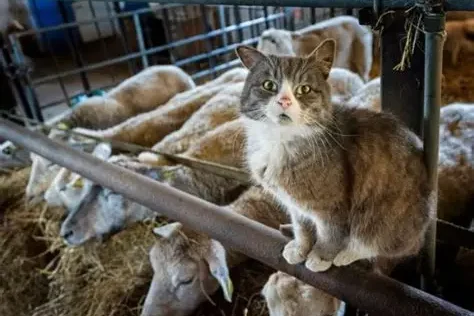
Historically, cats hung out in barns to keep mice away. Farmers kept cows, and where there were cows, there was milk. When cream and milk spilled from pails, cats got a taste. Opportunistic as ever, they lapped it up, not because they loved dairy, but because it was available. The image of a barn cat sipping milk looked charming. Farmers noticed, smiled, and kept the story alive. Over time, it stopped being coincidence and became expectation. That little act of convenience started the lifelong association between cats and milk that no one ever thought to question.
3. Cream, Not Milk

Centuries ago, milk wasn’t the processed liquid we drink today. It was raw and rich, with thick cream floating at the top. Cats, naturally drawn to fat, loved the taste of that creamy layer. People saw it and assumed all milk was the same. Over time, the difference between cream and milk blurred. When homogenization became standard, the creamy layer disappeared, but the myth stayed strong. What cats once enjoyed was the fatty top of old-fashioned milk, not the skimmed versions we know now. Still, the world remembered the image, not the truth hiding beneath it.
4. The Folktale Glow-Up
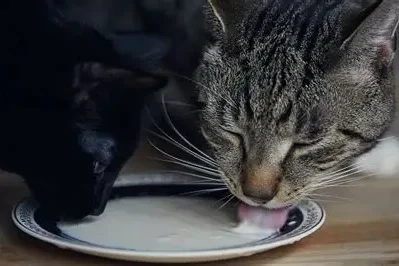
As cats moved from barns to homes, their image softened. By the 18th century, European writers and artists began depicting kittens lapping milk as symbols of comfort and innocence. The cozy scene became a household ideal, a picture of tenderness that fit perfectly into nursery tales and paintings. People adored the idea of cats as gentle companions instead of hunters. The truth of digestion mattered less than the warmth the image brought. Slowly, the milk myth became part of culture itself, woven into art, bedtime stories, and the quiet corners of domestic life.
5. The Victorian Stamp
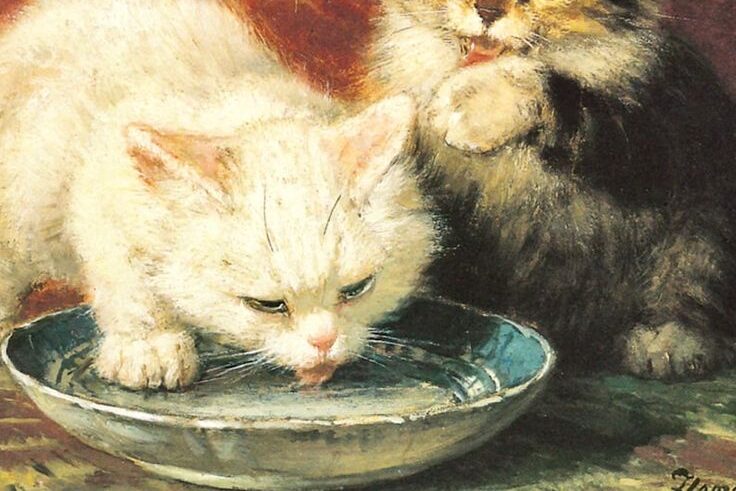
During the Victorian era, order and elegance ruled the home. Manuals on pet keeping advised milk in saucers as the ideal meal for cats. Hunting mice seemed too wild and improper, but a cat quietly sipping milk appeared sophisticated and well-behaved. The image suited middle-class ideals of manners and presentation. Soon, the sight of milk and cats together became a mark of refinement. What started as a visual of good housekeeping turned into habit. Even when science advanced, culture held on to that polished Victorian picture of feline grace beside a bowl of milk.
6. Milk as Innocence Symbol

To the human eye, milk meant purity and care. It symbolized goodness, health, and gentleness. When artists and advertisers paired it with kittens, the emotion doubled. The creamy liquid next to soft fur created an image too perfect to resist. People didn’t need proof to believe it. The combination looked right, so it felt right. Soon, the pairing of cats and milk wasn’t about reality but representation. It was innocence bottled up in one simple picture, repeated so often that no one bothered to ask if it ever made sense in the first place.
7. Enter the Animation Era

When cartoons arrived, visual shortcuts became essential. Animators needed audiences to recognize characters quickly. To show a cat, they drew a saucer of milk. It was familiar, harmless, and easy to understand. From Felix the Cat to Sylvester and Tom, every animated feline reinforced the same pattern. The more audiences saw it, the more it felt true. Animation turned myth into mainstream. Generations of children learned what cats liked before ever meeting one, and once that idea took root in imagination, there was no going back to the scientific truth.
8. Disney Doubles Down
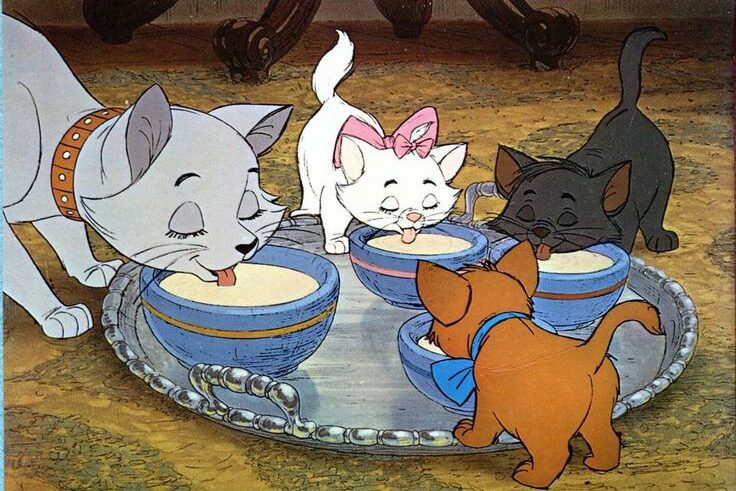
Then came Disney’s The Aristocats in 1970, and the illusion reached its peak. Elegant felines drank cream as if it were champagne. The imagery was dazzling, sophisticated, and irresistible. Disney’s storytelling power transformed milk from barnyard accident to luxury indulgence. The moment Duchess and her kittens sipped their creamy treat, audiences around the world believed the myth completely. Disney didn’t just entertain; it educated through charm. What once was biology became fantasy, and fantasy became fact. After that, no one questioned whether cats should drink milk. It had become cinematic truth forever.
9. Ads Milk It Literally
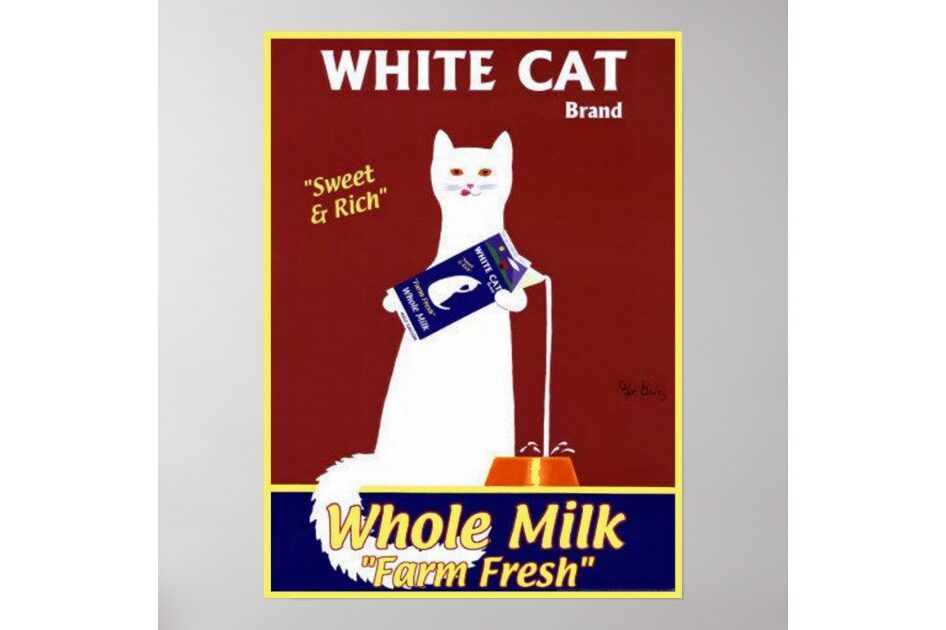
After Disney’s success, the dairy industry saw opportunity. Advertisers filled posters and commercials with kittens and milk mustaches. If cats looked healthy and happy drinking milk, it must be good for everyone. The message was emotional rather than factual, and it worked perfectly. Milk was no longer just a drink; it was comfort and connection. Children begged their parents to pour milk for their pets, unaware of the aftermath. The image of a cute kitten licking milk turned into one of the most powerful marketing tools of the twentieth century.
10. Pet Food Packaging
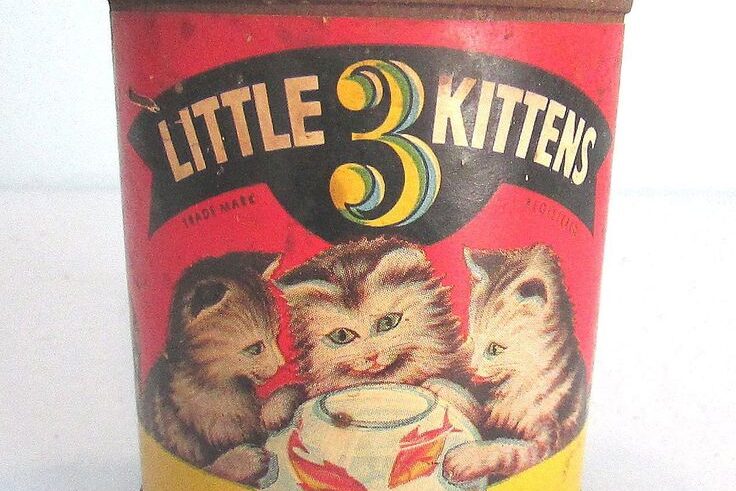
Once advertising embraced it, pet brands followed. Early cat food tins and bags often featured pictures of kittens beside bowls of milk. Whether or not the recipe included dairy didn’t matter. The packaging told a story people already believed. Milk meant happiness, health, and home. The image sold more than science ever could. Consumers trusted what they recognized, not what was true. By the time veterinarians began warning against it, the connection between milk and cats was already too deep to untangle. Marketing had permanently sealed the story in every household.
11. Children Reinforce the Cycle
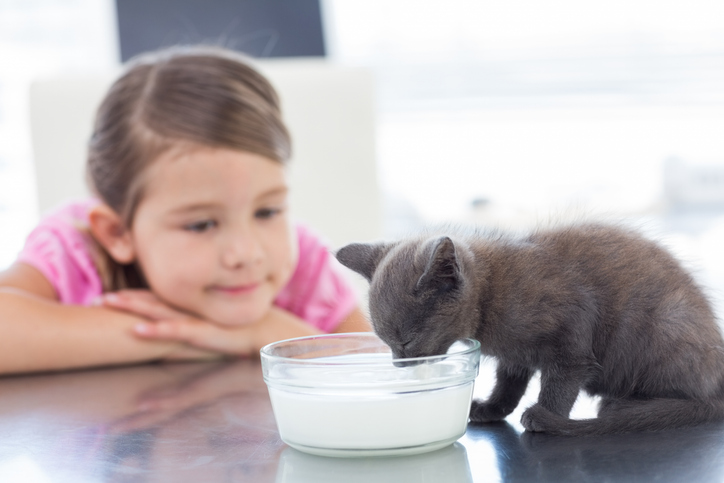
Kids grew up watching cartoons and reading books that showed milk as every cat’s favorite treat. When they got their own pets, they imitated what they had seen. Parents approved because it seemed safe, and the cats, curious as always, took a sip. The scene looked adorable and felt natural. Few noticed the upset stomach that sometimes followed. The cycle repeated generation after generation. Cultural learning became family tradition. In that quiet act of kindness, the myth survived, passed along not by experts, but by childhood memory and affection.
12. Some Cats Actually Love It
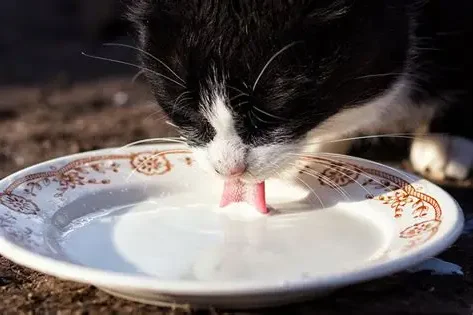
Here’s where things get tricky. Like humans, not all cats are alike. Some retain enough lactase to digest milk comfortably. These rare cats genuinely enjoy it, and their owners assume milk is universally safe. Stories spread quickly, and one healthy milk drinker became proof for many. The exceptions reinforced the belief and gave the myth new life. It’s easy to trust personal experience, especially when it looks so sweet. A content cat lapping from a bowl is hard to argue with, even when most others would end up queasy from the same indulgence.
13. Others Pay the Price
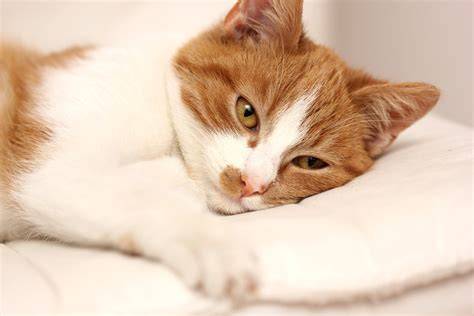
For many cats, milk leads to discomfort. Without the right enzyme, lactose sits in their digestive system causing bloating, gas, and loose stools. Owners often miss the connection because symptoms appear hours later. The cute moment remains in memory while the consequences fade away. Over time, these quiet reactions never made it into the cultural narrative. People shared the smiles, not the science. And so, while most cats paid the price in silence, the world kept pouring, unaware that the thing meant to show love sometimes did the opposite instead.
14. Science Tries to Speak Up
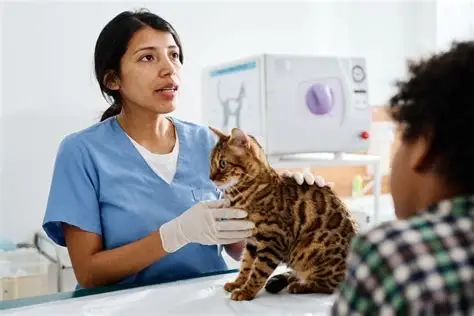
Veterinarians have spent decades repeating the truth: adult cats do not need milk. Water and proper nutrition are enough. But culture moves faster than caution. Once an image becomes beloved, facts lose their voice. Pet guides, online articles, and vet clinics have tried to change minds, but nostalgia is powerful. The milk myth feels comforting, and comfort sells better than caution. Even with modern awareness, the story continues to outshine science. People prefer the picture they grew up with to the advice printed on pamphlets they rarely bother to read.
15. Cat Milk Hits Stores
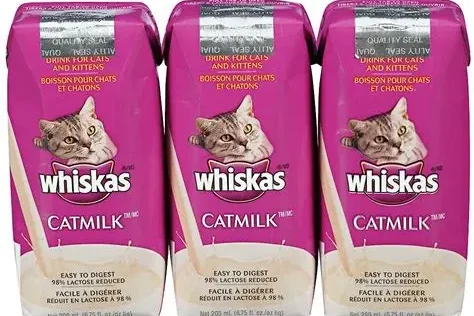
To solve the confusion, companies introduced lactose-free cat milk. It was safe, digestible, and designed to mimic the same creamy look. Ironically, it strengthened the myth rather than replacing it. Now, there was a whole product made to keep the illusion alive. Owners felt reassured, and cats enjoyed the flavor without trouble. The story evolved instead of ending. What began as an old farm coincidence had now become an entire industry, built to satisfy both feline taste buds and human nostalgia for the image we never wanted to let go of.
16. The Café Reinforcement
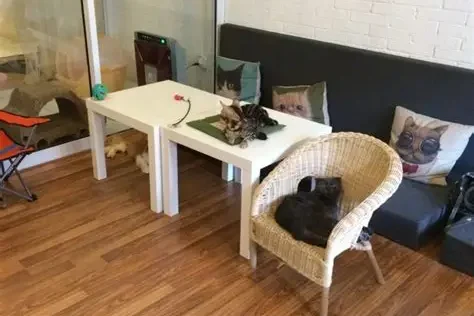
When cat cafés began trending, the saucer scene returned. Visitors loved snapping photos of cats beside milk, even if it was lactose-free. The experience mattered more than the contents. Instagram filled with warm lighting, sleepy cats, and creamy cups. The visual was irresistible, keeping the milk myth alive in the digital era. What once appeared on painted canvases now thrived in curated feeds. Modern cat culture still depends on aesthetics, and nothing says cozy like a cat and milk together, no matter what the science quietly continues to say otherwise.
17. Cartoons Go Global
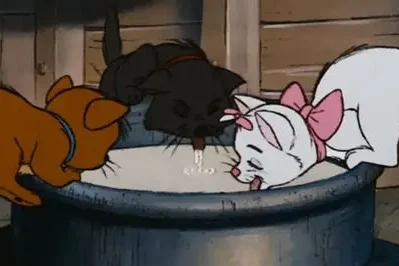
The image didn’t stay in one place. As animation spread worldwide, so did the myth. Japanese, British, and American studios all echoed the same scene. It became a universal language of comfort. Even cultures that rarely consumed milk adopted the image of cats drinking it. Over decades, that repetition turned into belief. The story transcended borders, carried by childhood memories, art, and entertainment. Whether you grew up watching Tom and Jerry or local cartoons, you probably saw the same thing: a cat, a saucer, and a story that still feels right today.
18. Greeting Card Eternal Life
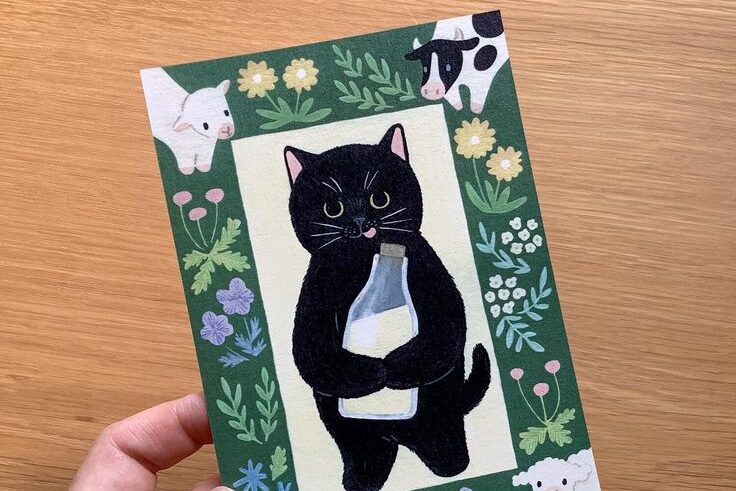
Walk into any card shop, and you’ll find kittens with bowls of milk on birthdays, baby announcements, or thank-you notes. It’s tradition now, not accuracy. Designers reuse familiar images because they evoke joy. People buy them because they feel warm and safe. Facts rarely sell as well as feelings. So, the milk myth continues its quiet afterlife in stationery and souvenirs. Each card, each mug, each calendar keeps that cozy illusion alive. The world doesn’t question what feels nostalgic, and so the picture keeps smiling back, unchanged through generations.
19. Nostalgia Protects the Myth

Even people who know better still love the sight. It reminds them of simpler times and cozy mornings when life felt slower and sweeter. The connection between cats and milk is no longer about biology; it’s about belonging and comfort. To question it feels like undoing a cherished memory. Generations have passed down this image as a symbol of affection, home, and innocence. It’s part of how we remember love itself. The truth sits quietly in the background, but nostalgia guards the myth like an old friend we never want to say goodbye to.
20. Blame Disney and the Barn Cats

It began with barn cats licking cream, grew through art, flourished under Disney, and settled into our culture like a bedtime story. Some cats can handle milk, most can’t, but the image persists. Maybe it’s not about milk at all. Maybe it’s about how we see comfort and companionship. The saucer isn’t for them anymore, it’s for us. A little reminder of gentleness in a noisy world. So next time your cat stares as you pour cereal, smile. Give water instead. The love stays the same. The myth, beautifully, will never fade.
So next time your cat stares at you while you pour cereal, remember milk isn’t universal cat food, it’s a cultural myth. Some felines get lucky and digest it just fine, others don’t. The image, however, will never die. Thanks to barns, Disney, and nostalgia, the milk saucer will always sit beside the cat in our imagination, whether or not it belongs there.
This story 20 Steps to How Disney Fooled the World into Believing Cats Love Milk was first published on Daily FETCH


